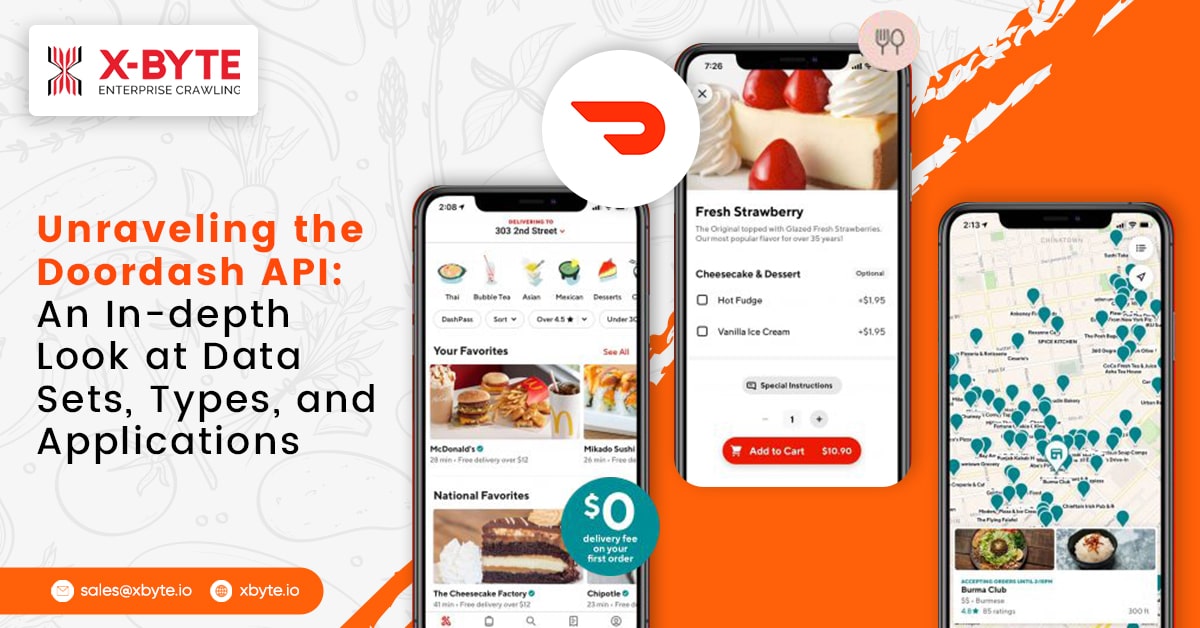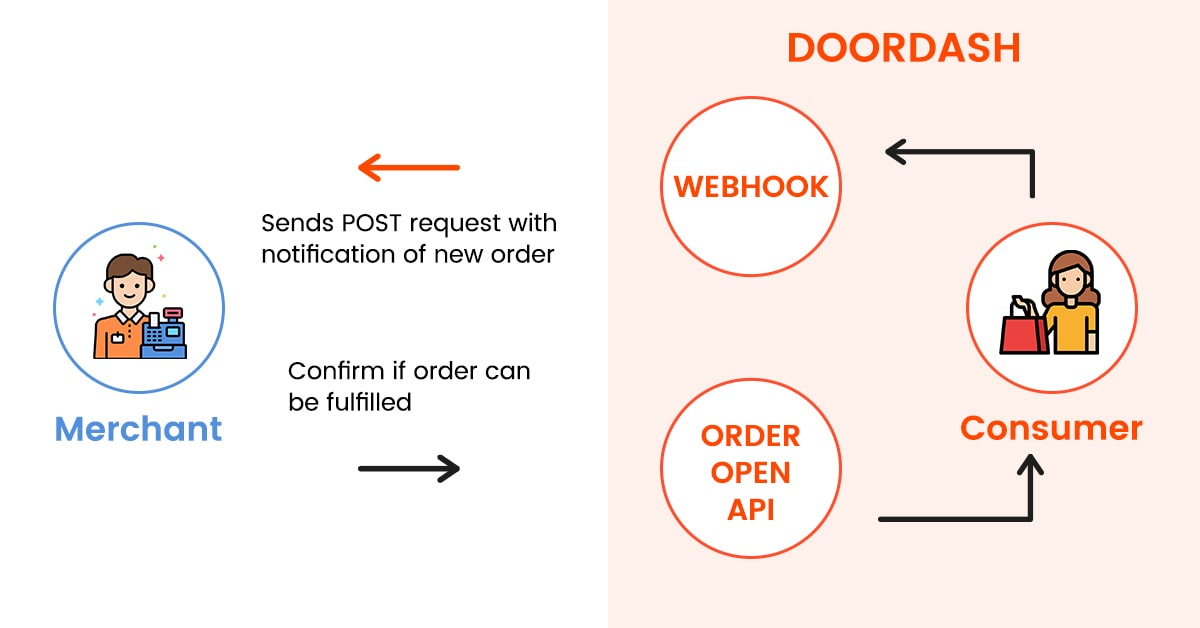
Developers get access to various data sets connected to the well-known meal delivery platform through the DoorDash API. These data sets provide valuable details about restaurants, menus, orders, and drivers, enabling programmers to build cutting-edge applications that improve customer experience, streamline processes, and uncover insightful information. We will go into the many data sets provided by the DoorDash API in this article and examine their numerous uses and applications. Developers can use the DoorDash API to create solid and effective meal delivery services by realizing the possibilities of these data sets.
A well-known meal delivery business called DoorDash makes its API available to developers so they may incorporate the data into their projects. Designers may enhance their apps for Food Delivery Services or restaurants by utilizing the DoorDash API. This API allows them to have accessibility to a variety of capabilities and information sets.
Restaurant searching, brochure extraction, placing orders, and delivery monitoring are just a few features available through the DoorDash API. Developers scrape business data like menus and prices and the ability to initiate orders on behalf of consumers. They can also track the progress of deliveries and gain the ability to perform searches for eateries according to a physical location, cuisine, or other criteria.
Brief Overview of Doordash as a prominent food delivery platform
Known for connecting customers with various eateries and enabling on-demand delivery solutions, DoorDash is a well-known system for meal delivery. DoorDash, which began operations in 2013 by Tony Xu, Stanley Tang, Andy Fang, and Evan Moore, quickly grew its business and significantly impacted the food delivery sector.
DoorDash, an online service that prioritizes the needs of its customers, presents an intuitive website and smartphone applications that let consumers discover a variety of eateries and foods in their neighborhoods. Customers can easily place orders at their favorite restaurants while browsing menus and reading reviews.
DoorDash collaborates with an enormous pool of eating establishments, from neighborhood joints to big-name franchises. This gives customers a wide variety of meal choices. The online platform provides elements to improve the whole delivery experience, including scheduling and bulk purchases, delivery without contact, and real-time monitoring of orders.
Via the DoorDash for Work program, which offers business lunches and meal delivery options to corporations and other consumer-facing offerings, DoorDash likewise serves commercial customers.
The Functionality of Doordash
DoorDash brings an elaborate bunch of features to the users. These features can serve restaurant partners as well as developers in many ways. Some of the critical operations that DoorDash offers include the following:
Restaurant Exploration: DoorDash users can look for various eateries in their neighborhood. Customers may look for eating places by region, culinary style, or specific foods. Customers may make sound choices thanks to the platform’s comprehensive business profiles, which include food options, feedback, and images.
Meal Ordering: Using the DoorDash system, customers can quickly order meals via their favorite eateries. Through the mobile application, consumers may personalize their purchases, choose pickup or delivery options, and safely checkout. DoorDash offers an easy and intuitive ordering method.
Monitoring: Users can also monitor the status of their food delivery orders in real time through DoorDash. Customers can follow the quality of their orders, get notifications about potential delivery windows, and, if necessary, contact the delivery person. This function improves ease and clarity.
DashPass: DoorDash has a membership service called DashPass. Members get advantages like no shipping costs, lower service costs, and special savings from select eateries. For regular DoorDash customers, DashPass improves economy and utility.
DoorDash for Business: DoorDash provides a unique company-centric program called DoorDash for Work. Due to this service, businesses can order and oversee meals for staff members, which offers business dining services and catering services for workplaces.
Solutions for Restaurant Partnerships: DoorDash offers a variety of offerings to its restaurant collaborators, like order handling software, delivery arrangements, and advertising possibilities to increase consumer traffic. The DoorDash network may help businesses reach more customers and run their businesses more efficiently.
Rankings and Feedback: DoorDash allows people to score and discuss their dining, delivery, and ordering experiences. This gives businesses and other customers helpful input. Eateries’ standing and general quality evaluations depend on these evaluations and ratings.
The Significance of Doordash API for Developers

Designers hoping to incorporate food deliveries in their apps or create ground-breaking restaurant market services will find a lot of helpful information in the DoorDash API. For programmers, the DoorDash API is essential for the following main factors:
Accessibility to Food Delivery Facilities: The DoorDash API gives programmers accessibility to the vast DoorDash collection of eateries and shipping infrastructure. By integrating food delivery services into their applications, programmers can increase the range of amenities they offer to users and grow their customer base.
Integrating seamlessly: The DoorDash API is written with developers in mind, including explicit information and set touchpoints. Rather than spending the effort and time creating their meal delivery network from the ground up, programmers can now easily include DoorDash’s capabilities in applications.
Better User Engagement: By incorporating the DoorDash API, programmers may improve the user interface and, thereby, engagement. This is possible by enabling on-demand meal delivery in the apps. Customers may easily place meal orders through the app or site, instantaneously see their orders’ progress, and benefit from DoorDash’s efficient delivery network.
Additional Restaurant Options: The DoorDash API enables builders to give users access to a large selection of restaurants. Users may place orders from different restaurants with a single uniform system, see the menus, and peruse comments.
Prospects for Business: By connecting the DoorDash API, programmers may capitalize on the expanding food delivery sector to establish fresh company ventures. They can develop restaurant locators, food delivery aggregators, or even creative solutions that utilize DoorDash’s distribution network for non-food services.
Types of Data Sets Offered by the Doordash API
Designers can use the link to many data sets given by the DoorDash API to improve their apps and services in the meal delivery business. The DoorDash API provides the following main categories of data sets:
Data about restaurants: The API extracts extensive information about restaurants, including names, addresses, cuisines, times of operation, food options, and images. With this collection of information, developers may give users in-depth eatery descriptions and simplify restaurant exploration.
Menu Information: Details about food choices, descriptions, costs, and personalization options are all accessible through the DoorDash API. This data collection is helpful for designers to present menus on their software, allow consumers to customize what they order, and show precise price information.
Purchase Data: Information about customer orders is available to builders, like order information, transaction IDs, dates and times, etc. With the help of this set of data, programmers may improve the distribution process by updating users on the status of their orders and tracking their progress in real-time.
Fulfillment Information: The API scrapes data regarding the distribution procedure, like driver details, delivery locations, and data on the track. With this data collection, developers may offer users smooth delivery experiences, punctual shipment monitoring, and delivery alerts.
Rankings and Opinions: The DoorDash API gives developers the ability to retrieve evaluations and rating information so they may incorporate user feedback into their mobile apps. Users can use this collection of information to make sound choices using their observations of other people, and companies can utilize it to collect customer feedback to enhance their offerings.
Customer data: Consumer information, including profile information, details about accounts, and purchase histories, are accessible to programmers via the API. This information can be taken to provide order history recording, personalize customer experiences, and simplify managing users within apps.
Conclusion
Developers can improve the performance within their programs, offer a wider selection of offerings to consumers, and simplify the meal delivery process by learning and utilizing the DoorDash API.
